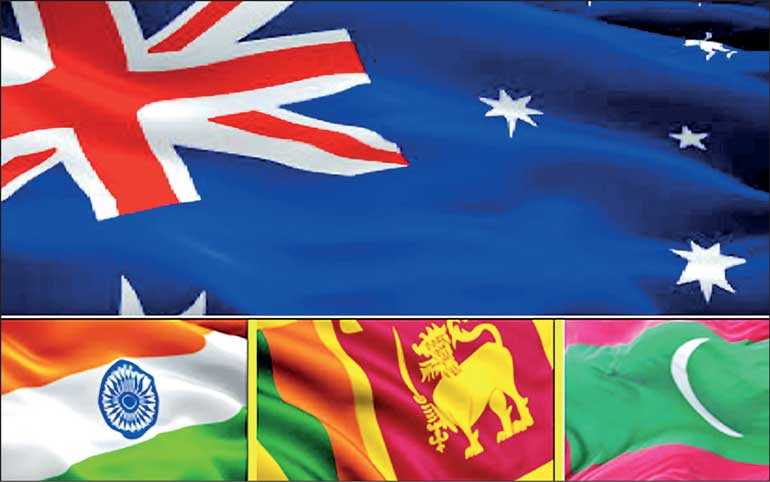Friday Feb 14, 2025
Friday Feb 14, 2025
Wednesday, 12 February 2020 00:00 - - {{hitsCtrl.values.hits}}

By Srimal Fernando
and Ellise Camilleri
There is much scholarship on the rising power of Southeast Asian countries. Australia’s foreign policy reflects this attention on Southeast Asia with much being done to secure relationships with major powers such as Japan and South Korea. This article will shift the focus onto Australia’s relationship with South Asian nations specifically India, Sri Lanka and the Maldives. 
For Australia, India is a vital strategic partner in the South Asian region. With this strategy in mind Australia has been working to access the 1.3 billion Indian consumer market and also has been trying to cooperate with Sri Lanka and the Maldives due to their vital geographical position in the Indian Ocean.
Australian foreign policy is playing an increasingly important role in the world. Furthermore, India Sri Lanka and the Maldives are member states of regional intergovernmental union namely the South Asian Association for Regional Cooperation (SAARC).
India has the largest economy in the South Asian region, with India’s Gross Domestic Product (GDP) expected to double from $ 2.5 trillion to $5 trillion. This will impact the future roles of both India and its neighbours.
The ongoing collaboration and close cooperation between these three countries will further intensify the economic and diplomatic opportunities for Australia beyond the South Asian realm. In its economic relations with Australia in the recent past India, Sri Lanka and the Maldives have seen growth in the areas of tourism and education.
Tourism
The South Asian region relies significantly on tourism for its economic growth. Australia plays an important role in the tourism sector for India and the two Indian Ocean island nations. Hence being one of the biggest foreign income earners. Securing a strong relationship with India now will benefit Australia significantly especially in the tourism and education sectors.
It is also important to look at how Australia is engaging with other nations in South Asia. The tourism sector of the South Asian nations is seeing improved prospects with an increasing number of Australian tourists frequenting each year.
Over 373,000 Australians visited India in 2019, increasing its rank to the eighth most visited place by Australian tourists (Australian Bureau of Statistics, 2019). This was a 7.3% annual increase from November 2018 to 2019. This growth in tourism has bolstered air connectivity between the two nations operating more flights weekly.
The two island nations south of India are also popular for Australian travellers evident through the statistics. The Australian Department of Foreign Affairs and Trade reveals Sri Lanka as the 20th most popular destination for Australians in 2019 with 114,000 Australians visiting the island nation.
Direct flights operate out of Melbourne to Colombo which has contributed to the increasing number of Australians visiting. Increasing direct flights from more Australian major cities to Colombo would further support tourism.
From an Australian traveller’s perspective, the Taj Mahal, one of the Seven Wonders of the World, and the beaches of Goa attract travellers to India. Looking south to the two island nations, Australians long to experience the natural wonders of Sri Lanka including the tea gardens and sandy beaches. In the Maldives the dive spots are seen as very attractive. Australia should work with these nations to enhance these itineraries above.
Education
Some South Asian countries are yet to increase the entries of students going to universities for undergraduate and master’s level courses. In this regard, Australia has much to offer in terms of education.
Reasonable and standard education provided by the Australian higher educational institutes is providing chances for students to travel to Australia instead of the Europe or the US. Six Australian universities being placed in the top 100 of the 2020 Times Higher Education World University Rankings further entices students to study here. Students from the SAARC nations are increasingly choosing to study in Australia also because of the permanent residency process.
Education is Australia’s largest service export to India, valued at AUD 5.5 billion. Over 120,000 Indian, Sri Lankan and Maldivian students studied in Australian schools. In addition to this Australia’s education related travel exports to the Maldives were worth $ 9 million in 2018 (Department of Foreign Affairs and Trade, 2018, 2019).
Australia has committed to furthering education ties in the Indo-Pacific region through the New Colombo Plan which allows and supports scholars study in the region. This has seen Australian students participate in programs throughout SAARC nations.
Conclusion
Through looking at the ties Australia and South Asia have in relation to education and tourism, it is clear Australia has established a strong mission to further its relationship with India acknowledging its current and growing power and potential. However, it has further room to grow its relationship with the Maldives and Sri Lanka.
The points above highlight the significant room for growth and expansion that Australia and SAARC nations offer in the future through economic policy.
[Srimal Fernando is a Doctoral Fellow at Jindal School of International Affairs (JSIA), India and a Global Editor of Diplomatic Society for South Africa. He is the winner of the 2018/2019 ‘Best Journalist of the Year’ award in South Africa, and has been the recipient of GCA Media Award for 2016.]
[Ellise Camilleri currently in her fourth year studying a Bachelor of Arts/Education (Secondary) at the University of New South Wales, Sydney. A New Colombo Mobility Scholar recipient, participating in a three week study programme at O.P Jindal Global University, India.]
Discover Kapruka, the leading online shopping platform in Sri Lanka, where you can conveniently send Gifts and Flowers to your loved ones for any event including Valentine ’s Day. Explore a wide range of popular Shopping Categories on Kapruka, including Toys, Groceries, Electronics, Birthday Cakes, Fruits, Chocolates, Flower Bouquets, Clothing, Watches, Lingerie, Gift Sets and Jewellery. Also if you’re interested in selling with Kapruka, Partner Central by Kapruka is the best solution to start with. Moreover, through Kapruka Global Shop, you can also enjoy the convenience of purchasing products from renowned platforms like Amazon and eBay and have them delivered to Sri Lanka.
Discover Kapruka, the leading online shopping platform in Sri Lanka, where you can conveniently send Gifts and Flowers to your loved ones for any event including Valentine ’s Day. Explore a wide range of popular Shopping Categories on Kapruka, including Toys, Groceries, Electronics, Birthday Cakes, Fruits, Chocolates, Flower Bouquets, Clothing, Watches, Lingerie, Gift Sets and Jewellery. Also if you’re interested in selling with Kapruka, Partner Central by Kapruka is the best solution to start with. Moreover, through Kapruka Global Shop, you can also enjoy the convenience of purchasing products from renowned platforms like Amazon and eBay and have them delivered to Sri Lanka.